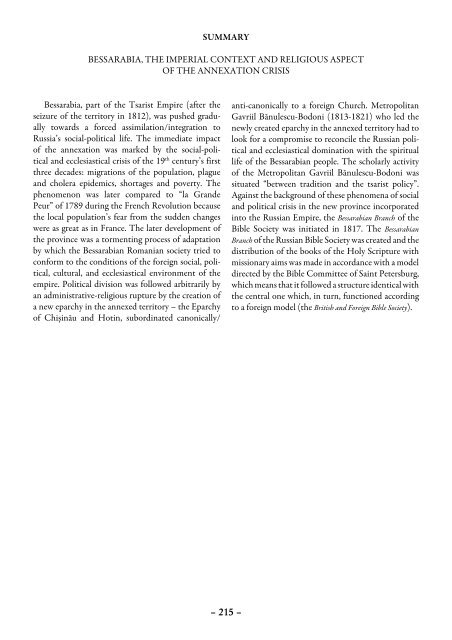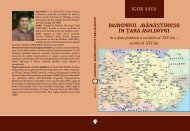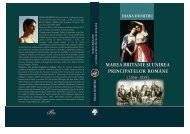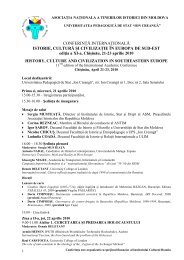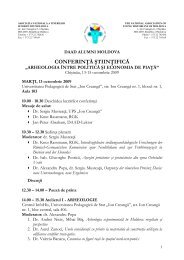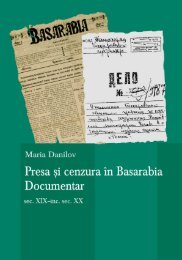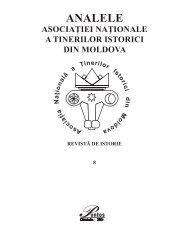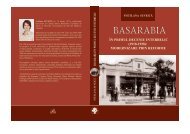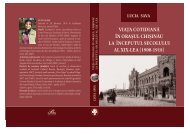- Page 2 and 3:
TRATATUL DE PACE DE LA BUCUREŞTI D
- Page 4 and 5:
TRATATUL DE PACE DE LA BUCUREŞTI D
- Page 6 and 7:
CUPRINS Introducere................
- Page 8 and 9:
INTRODUCERE În anul 2012, în Euro
- Page 10 and 11:
MUTAŢII ÎN SISTEMUL POLITIC EUROP
- Page 12 and 13:
ţarul Alexandru I. La realizarea a
- Page 14 and 15:
precum şi cele ale Bourbonilor şi
- Page 16 and 17:
toamna anului 1818, a marcat sfâr
- Page 18 and 19:
from its continental allies, becaus
- Page 20 and 21:
REPERCUSIUNILE PREZENŢEI ARMATEI R
- Page 22 and 23:
cunoscută fiecărui om chiar şi
- Page 24 and 25:
iar acum aceleaşi armate trec prin
- Page 26 and 27:
Populaţia de la frontiera de apus
- Page 28 and 29:
61 (5,9%), Greceni - 50 (4,9%), Hot
- Page 30 and 31:
Mai frecvente, decât în prima per
- Page 32 and 33:
periods: 1812-1818 and 1819-1828, c
- Page 34 and 35:
Tabelul 2 Plângerile ţăranilor
- Page 36 and 37:
Tabelul 4 Plângerile ţăranilor
- Page 38 and 39:
МОЛДОВА, ГОД 1812: ПОП
- Page 40 and 41:
фицировать как жал
- Page 42 and 43:
кэуского цинута на
- Page 44 and 45:
ПОЛОЖЕНИЕ РУМЫНСКИ
- Page 46 and 47:
нокомандующему рус
- Page 48 and 49:
в Горжинском уезде
- Page 50 and 51:
Принимая во вниман
- Page 52 and 53:
SUMMARY POSITION OF THE ROMANIAN PR
- Page 54 and 55:
ANUL 1812 SUB IMPACTUL FACTORULUI F
- Page 56 and 57:
piedica principală în calea ader
- Page 58 and 59:
evoluția medicinii și de aplicare
- Page 60 and 61:
Cert se prezintă că, în timp ce
- Page 62 and 63:
La 30 ianuarie (11 februarie) 1811
- Page 64 and 65:
că hotarul pe râul Siret era inac
- Page 66 and 67:
uzi, soartă care, de obicei, este
- Page 68 and 69:
ASPECTE ALE CIRCULAŢIEI MONETARE
- Page 70 and 71:
Petersburg”, şi în Principate a
- Page 72 and 73:
ASPECTE ISTORIOGRAFICE CONTROVERSAT
- Page 74 and 75:
din Basarabia, trece în revistă p
- Page 76 and 77:
alungarea bandei lui Manaf Ibrahim,
- Page 78 and 79:
a lui Bairactar-Paşa 78 . În albi
- Page 80 and 81:
care a unui centru urban nou în su
- Page 82 and 83:
SUMMARY CONTROVERSIAL HISTORIOGRAPH
- Page 84 and 85:
REGULAMENTUL PRIVIND ORGANIZAREA RE
- Page 86 and 87:
Printre primele instituţii care au
- Page 88 and 89:
tului din 1818 de a adopta deciziil
- Page 90 and 91:
că „nimeni dintre ei nu poseda l
- Page 92 and 93:
Rezidentul plenipotenţiar i-a numi
- Page 94 and 95:
cu privire la carantină, aprobat d
- Page 96 and 97:
intermediul limbii ruse” 114 . Im
- Page 98 and 99:
IZOLAREA COMERCIAL-VAMALĂ A BASARA
- Page 100 and 101:
se întreprindă toate măsurile de
- Page 102 and 103:
asemenea, prin ordinul ministrului
- Page 104 and 105:
probată de funcţionarii vamali di
- Page 106 and 107:
pe care le întâmpina la exportul
- Page 108 and 109:
Odessa, under high demand on foreig
- Page 110 and 111:
СOLONIZĂRILE BULGARILOR ÎN BASAR
- Page 112 and 113:
statistice din această perioadă n
- Page 114 and 115:
Ion Balş, Panaiot Kazimir, Grigori
- Page 116 and 117:
comisia condusă de Iuşnevschi şi
- Page 118 and 119:
pentru drepturile lor şi cu ajutor
- Page 120 and 121:
ZUSAMENFASSUNG DIE KOLONISIERUNG DE
- Page 122 and 123:
PROBLEMA BASARABIEI DE SUD ÎN DISC
- Page 124 and 125:
oadelor culturii europene, ultima l
- Page 126 and 127:
comparaţie cu modelele imperiale e
- Page 128 and 129:
oficiale către ministrul de intern
- Page 130 and 131:
CONGRESUL DE PACE DE LA BERLIN, IND
- Page 132 and 133:
ilor garante ale Tratatului de la P
- Page 134 and 135:
nale au fost încălcate de acesta.
- Page 136 and 137:
au acceptat retragerea armatelor ru
- Page 138 and 139:
cu convingerea că forumul european
- Page 140 and 141:
Kogălniceanu, că nu ar fi apărat
- Page 142 and 143:
ECOURI ÎN ROMÂNIA ALE CENTENARULU
- Page 144 and 145:
Se evidenția, de asemenea, nevoia
- Page 146 and 147:
iilor absolute și semiasiatice ca
- Page 148 and 149:
ISTORIE ŞI DIPLOMAŢIE LA 1912. 10
- Page 150 and 151:
său Raymond Poincaré, considera a
- Page 152 and 153:
ţarist la Chişinău Pentru o soci
- Page 154 and 155:
acţiunea de la Biserica Antim, ini
- Page 156 and 157:
SUMMARY HISTORY AND DIPLOMACY IN 19
- Page 158 and 159:
DESTINUL BASARABIEI REFLECTAT ÎN L
- Page 160 and 161:
Exceptând intervenţiile lui Const
- Page 162 and 163:
Verussi” 46 . Era un gând păstr
- Page 164 and 165:
Serafim Ciceagov, „ziua aniversă
- Page 166 and 167: vedere cu temniţa politică din Ch
- Page 168 and 169: fost aranjate cu hărţi, stampe, d
- Page 170 and 171: interesului nostru faţă de Basara
- Page 172 and 173: presa timpului despre EVENIMENTUL D
- Page 174 and 175: S-au strâns, credem, vreo 10-15 00
- Page 176 and 177: Ceea ce trebuie de subliniat, în
- Page 178 and 179: ANEXAREA BASARABIEI: MENTALITATE Ş
- Page 180 and 181: primul rând, populaţia Basarabiei
- Page 182 and 183: mântului: „Cea de-a patra naţio
- Page 184 and 185: excelenţă modern şi a marcat, î
- Page 186 and 187: de cele de ordin economic şi socia
- Page 188 and 189: sunt mai mult negative, împrumutat
- Page 190 and 191: ANUL 1812 ŞI ÎNTRERUPEREA PROCESU
- Page 192 and 193: şcoliţi la colegiile iezuite din
- Page 194 and 195: abeni, formaţi în perioada interb
- Page 196 and 197: CANCELARIILE EUROPENE DIN PRIMA JUM
- Page 198 and 199: că românii din Moldova, Ţara Rom
- Page 200 and 201: În grupul acestora înglobează ş
- Page 202 and 203: Aceste constatări ne determină s
- Page 204 and 205: BASARABIA, CONTEXTUL IMPERIAL ŞI D
- Page 206 and 207: 1814, care impunea restricţii deos
- Page 208 and 209: În şedinţa din 28 februarie 1816
- Page 210 and 211: Macavei carte” 59 din cuprinsul B
- Page 212 and 213: editorială (1812-1821) a Societă
- Page 214 and 215: ierarhică/socială era respectată
- Page 218 and 219: BISERICA ORTODOXĂ DIN BASARABIA SU
- Page 220 and 221: Svetlana Prozorovchi 32 . Despre ar
- Page 222 and 223: ici în Chişinău (Sf. Treime, Sf.
- Page 224 and 225: căzuţi pe front, proiect care nu
- Page 226 and 227: Bogos, Alexandru Baltaga, Vladimir
- Page 228 and 229: conducere: egumeni, locţiitori de
- Page 230 and 231: produceau, cea mai mare parte a pre
- Page 232 and 233: CONSECINŢELE RAPTULUI TERITORIAL D
- Page 234 and 235: - una spirituală pentru băieţi (
- Page 236 and 237: ai acestei organizaţii. Devine sus
- Page 238 and 239: BISERICA ORTODOXĂ - INSTRUMENT DE
- Page 240 and 241: ţiei bisericeşti. După asasinare
- Page 242 and 243: ţele rusificării a fost înstrăi
- Page 244 and 245: ANEXA 1 Obiectele şi numărul de o
- Page 246 and 247: BASARABIA ÎN CONTEXTUL RELAŢIILOR
- Page 248 and 249: în baza certificatelor comerciale
- Page 250 and 251: vamale din Reni şi Sculeni, iar di
- Page 252 and 253: NOBILIMEA BASARABEANĂ, EVENIMENTEL
- Page 254 and 255: a primit vestea despre naşterea vi
- Page 256 and 257: Împărate! Actualul amestec al str
- Page 258 and 259: ROLUL NOBILIMII ÎN VIAŢA PUBLICĂ
- Page 260 and 261: şi „Bessarabeţ”, editate de P
- Page 262 and 263: MIŞCAREA NAŢIONALĂ DIN BASARABIA
- Page 264 and 265: Membrii societăţii „Milcov” d
- Page 266 and 267:
Господину Директор
- Page 268 and 269:
№ 9 Выписка из пись
- Page 270 and 271:
№ 13 Совершенно сек
- Page 272 and 273:
чески, в отношении
- Page 274 and 275:
CONTRIBUŢII LA ISTORIA ÎNVĂŢĂM
- Page 276 and 277:
semnificativ, întrucât numărul c
- Page 278 and 279:
şi prezenţa armatelor pe aceste t
- Page 280 and 281:
disciplinelor în limba rusă, înl
- Page 282 and 283:
itatea Ministerului Învăţământ
- Page 284 and 285:
1873, a şcolii reale din Chişină
- Page 286 and 287:
gîndirea pedagogică, Editura Şti
- Page 288 and 289:
EVACUAREA EVREILOR DIN TÂRGUL FLOR
- Page 290 and 291:
se permite deschiderea unui iarmaro
- Page 292 and 293:
3) aşezarea posedă o conducere ap
- Page 294 and 295:
was the location a fair or a villag
- Page 296 and 297:
IMPACTUL RELAŢIILOR SOVIETO-ROMÂN
- Page 298 and 299:
maţi despre atmosfera care a domin
- Page 300 and 301:
educaţiei marxist-leniniste au fos
- Page 302 and 303:
espective, atunci în politica „c
- Page 304 and 305:
ANUL 1812 ÎN DISCURSUL PUBLIC AL M
- Page 306 and 307:
vorbea despre faptul că în 1812 M
- Page 308 and 309:
Naţionale, din 16 decembrie 1990,
- Page 310 and 311:
separatiste de la Comrat şi Tirasp
- Page 312 and 313:
ANUL 1812 ŞI PIERDEREA BASARABIEI:
- Page 314 and 315:
· anexarea Basarabiei a fost, în
- Page 316 and 317:
anumitor imagini ale trecutului col
- Page 318 and 319:
în versuri, scrise în diverse tim
- Page 320 and 321:
APARIŢIA CHESTIUNII BASARABIEI ÎN
- Page 322 and 323:
parte știa foarte bine că dacă a
- Page 324 and 325:
a silit pe turci de a nu se folosi
- Page 326 and 327:
Convenția de la Erfurt era caducă
- Page 328 and 329:
supus spre vot Congresului, se con
- Page 330 and 331:
the dividing of areas of influence
- Page 332 and 333:
ANUL 1812 ÎN MANUALELE ȘCOLARE DI
- Page 334 and 335:
Prut și Nistru, căreia i-au dat n
- Page 336 and 337:
2008 40 . Aceste schimbări au cons
- Page 338 and 339:
În acest manual, informațiile des
- Page 340 and 341:
DOUĂ SUTE DE ANI DE OCUPAŢIE RUSE
- Page 342 and 343:
sprijinul aliaţilor şi al guvernu
- Page 344 and 345:
În cadrul politicii lingvistice, a
- Page 346 and 347:
în acest demers este faptul că ac
- Page 348 and 349:
RECENZIE Ion Agrigoroaiei, Basarabi
- Page 350 and 351:
Ucraineană. Este cuprins astfel ca
- Page 352 and 353:
14.00-15.30 Sesiunea 2: Anul 1812


